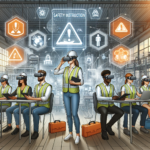Revolutionizing Supply Chain Management with Immersive Technologies 🌟
Introduction to Immersive Technologies in Supply Chain Management
In today’s fast-paced business environment, supply chain management (SCM) plays a pivotal role in ensuring that products move efficiently from manufacturers to consumers. With the advent of immersive technologies, businesses are finding innovative ways to enhance their operations. The integration of augmented reality (AR), virtual reality (VR), and mixed reality (MR) is transforming the way organizations approach their supply chains, providing significant advantages that save time, reduce costs, and improve overall effectiveness.
Understanding Immersive Technologies
Before diving deeper into their applications in supply chain management, it’s essential to understand what immersive technologies entail:
- Augmented Reality (AR): Enhances the real world by overlaying digital information onto it, allowing users to interact with their physical environment in new ways.
- Virtual Reality (VR): Creates entirely immersive digital environments, which users can explore and interact with, often using specialized hardware like headsets.
- Mixed Reality (MR): Blends the real and virtual worlds, allowing for dynamic interaction between physical and digital objects in real-time.
How Immersive Technologies Are Transforming Supply Chain Management
Using immersive technologies provides numerous advantages to businesses involved in supply chain management. Let’s explore some of the most impactful ways these technologies are making a difference:
1. Enhanced Training and Development
Training employees effectively is vital for smooth logistics operations. With immersive technologies, companies can:
- Create realistic training simulations: VR simulations can mimic various supply chain scenarios, offering employees hands-on experience without real-world risks.
- Utilize AR for on-the-job training: AR can provide real-time, step-by-step instructions overlaid on physical equipment, helping employees learn faster and more efficiently.
2. Real-Time Data Visualization
Immersive technologies allow businesses to visualize supply chain data in real-time, making it easier to track inventory levels, demand forecasts, and delivery schedules. Enhanced data visualization can lead to:
- Informed decision-making: Visualization tools can present complex data in easy-to-understand formats, enabling managers to make better strategic choices.
- Increased transparency: Stakeholders can gain a clearer picture of the entire supply chain process, from sourcing to delivery.
3. Improving Warehouse Operations
AR and VR can drastically improve warehouse management by optimizing space and minimizing errors. Key benefits include:
- Optimized picking routes: AR can guide warehouse workers with the most efficient paths to pick items, reducing time spent searching for products.
- Virtual warehouse layouts: Using VR, managers can simulate different warehouse configurations to identify the most efficient designs without physical disruption.
4. Enhanced Collaboration
Effective supply chain management relies heavily on collaboration between different teams and stakeholders. Immersive technologies facilitate communication in the following ways:
- Virtual meetings: VR allows teams to meet in a virtual space, offering a semblance of in-person interaction, regardless of geographical barriers.
- AR project sharing: Project stakeholders can view and discuss 3D visualizations of products or logistics plans overlaid in the real world, leading to enhanced cooperation and understanding.
5. Risk Mitigation and Predictive Analysis
The unpredictable nature of global supply chains demands that companies be prepared for disruptions. Immersive technologies can assist in:
- Scenario simulations: VR can be used to model various scenarios ranging from natural disasters to supply shortages, helping companies strategize proactive measures.
- Predictive analytics: Combining immersive technologies with data analytics can enable businesses to foresee potential supply chain disruptions and address them before they escalate.
Challenges and Considerations
While the integration of immersive technologies into supply chain management offers significant benefits, several challenges must be addressed:
- High initial investment costs: Implementing immersive technology can be expensive, requiring significant resources for training and hardware purchases.
- Change management: Companies need to cultivate a culture that embraces new technology, as resistance from employees can slow down the transformation process.
- Data security concerns: As immersive technologies involve extensive data collection and sharing, maintaining data privacy and security is paramount.
The Future of Supply Chain Management with Immersive Technologies
As immersive technologies continue to evolve, their capabilities will expand, leading to greater integration into supply chain processes. The future might hold:
- Seamless automation: The fusion of AI with immersive technologies could automate various supply chain tasks, resulting in even greater efficiency.
- Enhanced customer experiences: Businesses may leverage these technologies to provide customers with real-time tracking and visualization of their orders.
Conclusion
The transformation of supply chain management through immersive technologies is already underway, and the potential for future enhancements is immense. Companies that embrace these innovations will not only streamline their operations but also set a new standard for efficiency and transparency in the marketplace. As technology continues to advance, staying ahead of the curve will be essential for any business aiming for success in a competitive environment.




0 Comments